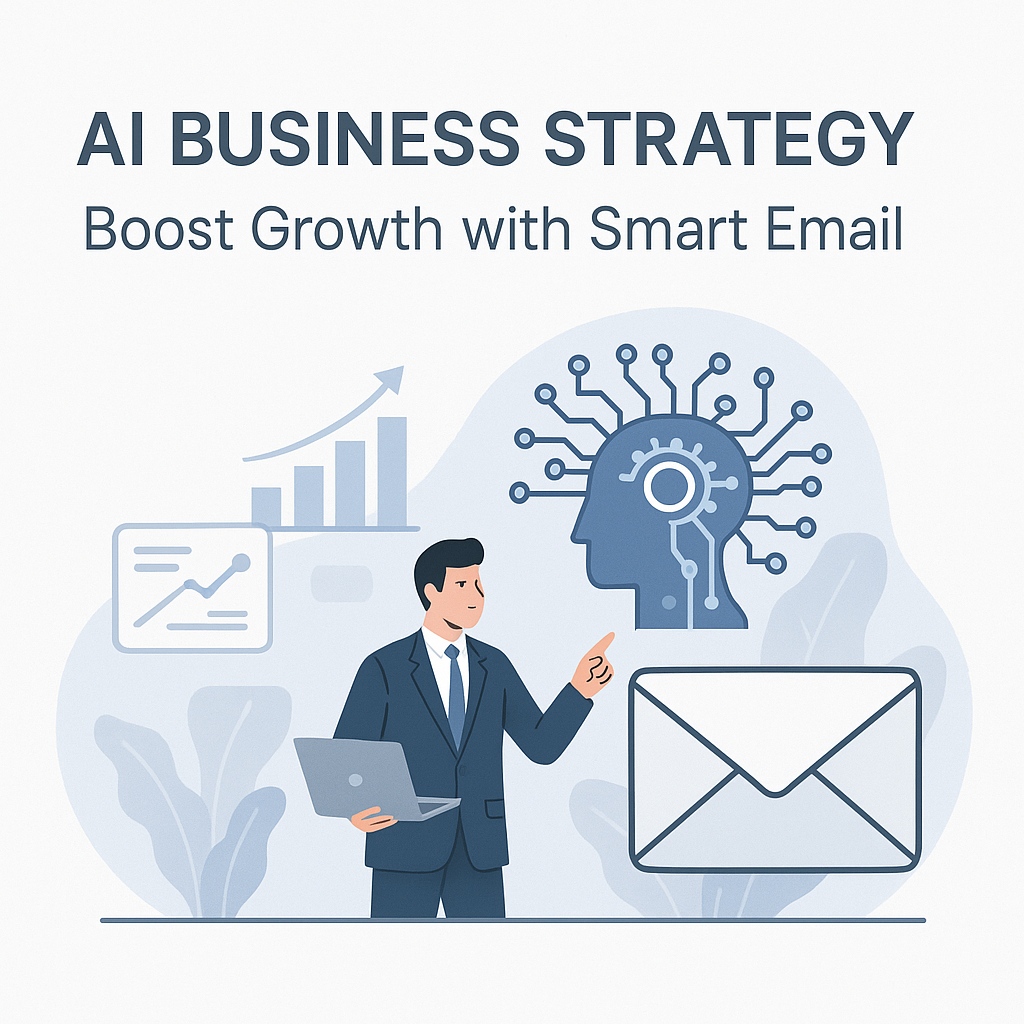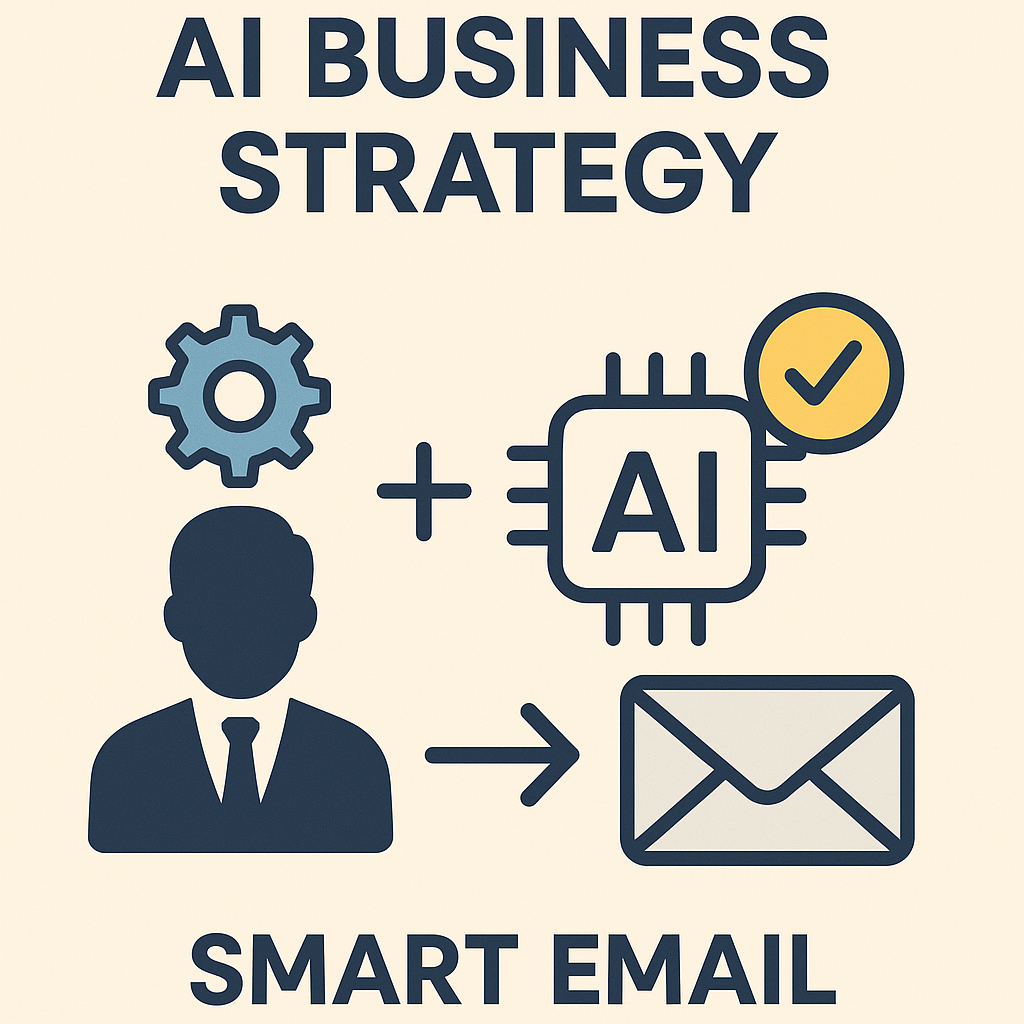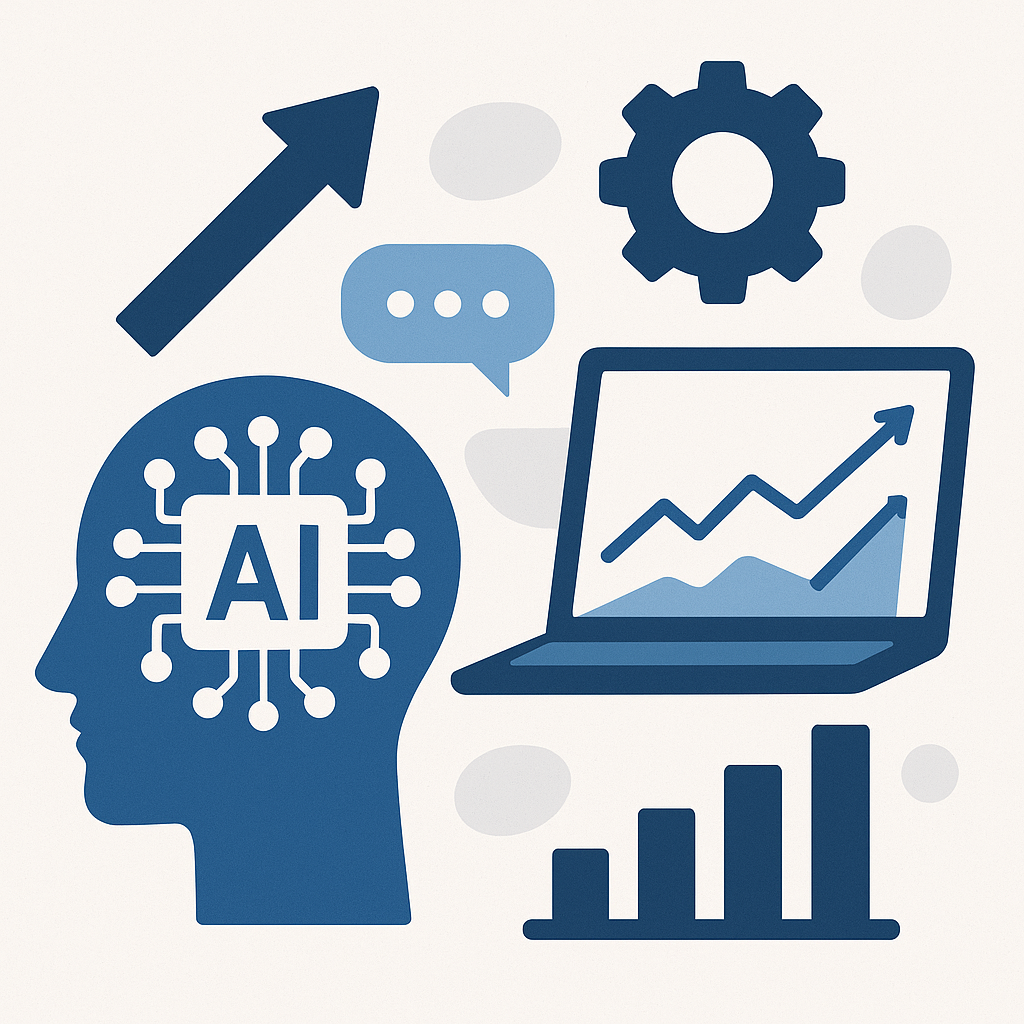AI Business Strategy: Boost Growth with Smart Email

In today's hyper-competitive business landscape, staying ahead requires more than just a solid plan; it demands agility, efficiency, and intelligent execution. Many organizations find themselves bogged down by the sheer volume of daily operations, particularly communication. Email, the ubiquitous tool for professional interaction, often becomes a significant bottleneck, hindering productivity and diverting precious time away from strategic initiatives. This is where a robust ai business strategy becomes not just an advantage, but a necessity. By harnessing the power of artificial intelligence, businesses can transform their communication workflows, starting with their inboxes, to unlock new levels of efficiency, foster better decision-making, and ultimately, drive sustainable growth.
The Role of AI in Modern Business Strategy
The integration of artificial intelligence into business operations is no longer a futuristic concept; it's a present-day reality reshaping industries. An effective ai business strategy is a comprehensive plan that outlines how AI technologies will be leveraged to achieve specific organizational goals, enhance competitive advantage, and drive innovation. As highlighted by IBM, "An artificial intelligence strategy is a plan for integrating AI into an organization so that it aligns with and supports the broader goals of the business." This means moving beyond isolated AI tools to a cohesive approach that infuses intelligence into every facet of the operation. From customer service and marketing to supply chain management and internal communications, AI offers transformative potential. However, the foundational elements of any business strategy are often built on clear communication and efficient operations, making areas like email management a critical starting point for AI adoption.
The landscape of business strategy itself is evolving. As PwC notes, "AI rewrites the playbook: Is your business strategy keeping pace?" Strategy is shifting from a static blueprint to a dynamic, data-driven process that adapts in real-time. AI enables this shift by providing the analytical power to process vast amounts of data, identify trends, and inform decisions with unprecedented speed and accuracy. This dynamic approach is crucial for navigating market changes and capitalizing on emerging opportunities. For leaders, this means reclaiming cognitive bandwidth to focus on the strategic vision rather than getting lost in the operational weeds. This is precisely why focusing on AI's impact on core productivity functions, such as email management, is so vital for developing and executing a successful business growth strategy.
Why Email Management is Crucial for Strategic Execution
Email remains a primary channel for business communication, project coordination, client interaction, and internal collaboration. However, the average professional spends a significant portion of their day managing their inbox. Studies consistently show that employees can spend anywhere from 2 to 4 hours daily on email, dealing with everything from critical client messages to promotional newsletters and internal updates. This constant influx can lead to:
- Information Overload: Difficulty in sifting through high volumes of messages to find what's truly important.
- Delayed Responses: Crucial communications get buried, leading to missed deadlines and frustrated stakeholders.
- Reduced Focus: Constant email checking fragments attention, impacting deep work and strategic thinking.
- Miscommunication: Nuance can be lost in text-based communication, leading to errors in execution.
- Lost Opportunities: Important leads, partnership proposals, or critical insights might be overlooked.
For executives and leadership teams, these inefficiencies are particularly detrimental. Their role demands high-level thinking, strategic planning, and decisive action. When their time is consumed by managing email, it directly detracts from their ability to lead effectively. This is where the concept of communication efficiency becomes paramount. Streamlining email management isn't just about tidying up an inbox; it's about ensuring that the flow of information supports, rather than obstructs, the execution of the business's core strategies. The ability to quickly identify, prioritize, and act upon critical communications is fundamental to maintaining momentum and achieving strategic objectives. A poorly managed email system can inadvertently sabotage even the best-laid plans.
AI's Impact on Email Productivity for Business Leaders
Artificial intelligence offers a powerful suite of tools and capabilities that can revolutionize email productivity, especially for busy professionals and leaders. The core benefit lies in AI's ability to automate repetitive tasks, intelligently filter information, and provide actionable insights, thereby enhancing executive productivity and freeing up valuable cognitive resources. AI can act as a force multiplier, enabling leaders to achieve more with less effort.
Here's how AI is making a significant impact:
- Intelligent Prioritization: AI algorithms can analyze incoming emails based on sender, keywords, sentiment, and historical interaction patterns to identify the most urgent and important messages. This ensures that critical communications rise to the top, allowing leaders to address them promptly. Tools that offer smart filtering and prioritization are key components of effective AI email management.
- Automated Responses and Drafting: For common inquiries or routine updates, AI can draft responses or even send automated replies, saving significant time. This capability is particularly useful for managing client communications or internal team updates, ensuring consistency and speed.
- Email Summarization: Long email threads or complex messages can be daunting. AI can provide concise summaries, extracting key points, decisions, and action items, allowing leaders to grasp the essence of a conversation quickly without reading every word. This is a critical aspect of boosting communication efficiency.
- Action Item Extraction: AI can scan emails to identify tasks, deadlines, and commitments, automatically adding them to to-do lists or calendars. This proactive approach helps prevent tasks from falling through the cracks.
- Sentiment Analysis: Understanding the tone of an email can be crucial for effective communication. AI can analyze sentiment, helping leaders gauge customer satisfaction, employee morale, or the general mood of a conversation, which can inform their responses and strategies.
By offloading these tasks to AI, leaders can dedicate more time to strategic planning, relationship building, and high-impact decision-making. This shift is fundamental to effective AI for leadership, empowering them to focus on what truly drives the business forward. It's about transforming email from a time sink into a strategic asset.
Practical AI Solutions for Taming Your Inbox
The challenge of email overload is pervasive, but a range of AI-powered solutions are available to help professionals regain control of their inboxes. These tools leverage machine learning and natural language processing to automate, organize, and streamline email interactions, significantly boosting email productivity tools and overall workflow efficiency. Embracing these solutions is a practical step towards implementing a comprehensive AI implementation strategy.
Consider the following AI-driven approaches to email management:
- Smart Inbox Prioritization Tools: These tools go beyond simple filters. They learn your communication patterns and priorities to highlight emails that require your immediate attention. For instance, an email from a key client about an urgent project might be automatically flagged and moved to a priority folder, while promotional emails are neatly archived.
- AI-Powered Drafting Assistants: Stuck on how to phrase a response? AI assistants can help draft professional emails quickly, suggesting phrasing, checking grammar, and even personalizing messages based on context. This speeds up the composition process considerably.
- Automated Scheduling and Response Management: Some AI tools can handle simple scheduling requests by finding mutually agreeable times and sending out calendar invitations, or manage common customer queries with pre-approved responses. This is invaluable for maintaining rapid communication cycles.
- Email Summarization and Key Takeaway Extraction: Imagine receiving a concise, bullet-pointed summary of a long email thread. AI tools can extract the main points, decisions made, and pending action items, allowing busy executives to quickly get up to speed without wading through multiple replies. This capability can be found in advanced AI email management platforms.
- Intelligent Filing and Organization: AI can automatically categorize emails, file them into relevant project folders, and even archive old conversations, keeping your inbox clean and searchable. This reduces the mental overhead associated with managing a cluttered inbox.
Implementing these solutions can dramatically improve communication efficiency. For example, consider the impact of having an intelligent assistant that can sort your communications, flag urgent matters, and even draft preliminary responses. Tools like an ai executive assistant can help streamline your workflow by intelligently managing your inbox, allowing you to focus on strategic priorities instead of getting lost in email clutter. Such tools are designed to handle the volume and complexity of modern professional communication, ensuring that critical information is surfaced and acted upon efficiently.
For those looking to optimize their experience with specific platforms, resources on managing Gmail with AI can offer tailored strategies. Similarly, understanding what makes an email client for productivity and speed can help in selecting the right tools to support your AI-driven email strategy.
Integrating AI Email Tools into Your Business Strategy
The adoption of AI for email management is not just about adopting new software; it's a crucial component of a broader digital transformation AI initiative. For businesses to truly leverage AI, it must be woven into the fabric of their strategic planning and execution. This requires a thoughtful approach to AI implementation strategy, ensuring that tools and processes align with overarching business objectives.
Here’s how to integrate AI email tools effectively:
- Assess Current Workflow Pain Points: Before implementing any AI solution, identify where email is causing the most friction. Is it response time, information retrieval, task management, or something else? Understanding these pain points will guide tool selection and implementation.
- Define Clear Objectives: What do you aim to achieve with AI-powered email management? Is it to reduce time spent on email by 20%, improve response times to key clients by 50%, or free up executive time for strategic thinking? Setting measurable goals is essential for evaluating success.
- Select the Right Tools: Based on your objectives, choose AI tools that offer the most relevant features. This might range from advanced inbox management platforms to AI assistants that integrate with your existing email client. Consider solutions that offer flexibility and scalability.
- Phased Rollout and Training: Introduce AI tools gradually, perhaps starting with a pilot team or department. Provide comprehensive training to ensure employees understand how to use the tools effectively and how they contribute to the broader ai business strategy. Address any concerns about AI replacing human interaction, emphasizing augmentation rather than automation of core relationships.
- Integrate with Other Systems: For maximum impact, AI email tools should ideally integrate with other business systems, such as CRM, project management software, or calendars. This creates a more cohesive digital ecosystem and allows AI to leverage data from multiple sources. For example, integrating email insights with customer data can provide a richer understanding of client relationships, a concept explored further in articles on conversational analytics.
- Foster a Culture of AI Adoption: Encourage employees to explore and adopt AI tools. Leadership buy-in and active participation are critical to demonstrating the value of AI and driving widespread adoption.
As MIT Sloan Review points out, AI is fundamentally changing how businesses operate and strategize. This evolution requires a proactive approach to adopting new technologies and rethinking traditional processes. By starting with a critical area like email management, businesses can build momentum for broader AI adoption and lay the groundwork for a more agile and intelligent future. This foundational step is vital for any organization looking to implement a forward-thinking AI implementation strategy.
Measuring the ROI of AI in Communication and Productivity
Implementing AI tools, especially for something as fundamental as email management, requires a clear understanding of their return on investment (ROI). Quantifying the benefits helps justify the expenditure, secure further investment, and refine the ai business strategy. The ROI for AI in communication and productivity can be measured in several key areas:
- Time Savings: This is often the most direct and measurable benefit. Calculate the average time employees spend on email daily and multiply it by the percentage of time saved through AI automation (e.g., drafting, sorting, summarizing). If an employee saves 1 hour per day, and you have 100 employees, that's 100 hours saved daily, translating to significant cost savings and increased output capacity.
- Increased Efficiency and Throughput: Faster response times, quicker task completion, and reduced errors lead to higher overall operational efficiency. This can translate to faster project delivery, improved customer satisfaction, and a higher volume of business handled without proportional increases in staff.
- Improved Decision-Making: By reducing information overload and highlighting critical data, AI enables leaders to make more informed decisions faster. This agility can lead to capturing market opportunities or mitigating risks more effectively, directly impacting the bottom line and contributing to the business growth strategy.
- Enhanced Employee Satisfaction and Reduced Burnout: When employees are freed from tedious tasks and communication overload, their job satisfaction often increases. Reduced stress and burnout can lead to lower employee turnover, saving recruitment and training costs.
- Better Client Relationships: Prompt, accurate, and personalized communication fostered by AI can significantly improve client satisfaction and loyalty. This directly supports revenue growth and market competitiveness.
For example, if an AI email assistant helps an executive reclaim 5 hours per week, that's 260 hours per year. If that executive's time is valued at $100/hour, the direct time savings alone are $26,000 annually per executive. When scaled across an organization, these savings become substantial. Furthermore, the qualitative benefits, such as faster strategic alignment and reduced errors, are harder to quantify but equally important for long-term success. Measuring these metrics allows businesses to demonstrate the tangible value of their AI implementation strategy and refine their approach.
Future Trends: AI and the Evolution of Business Communication
The role of AI in business communication is set to expand dramatically, moving beyond simple task automation to more sophisticated forms of interaction and intelligence. As AI continues to evolve, it will reshape how businesses communicate internally and externally, further embedding itself into the core of any forward-looking ai business strategy.
Here are some key future trends:
- AI-Powered Communication Agents: Imagine AI agents that don't just manage your inbox but actively participate in conversations on your behalf, negotiating terms, scheduling complex meetings across multiple parties, and even drafting initial proposals. This is the future of intelligent agents and sophisticated AI talking to AI, where systems collaborate to achieve business objectives.
- Predictive Communication: AI will increasingly predict communication needs before they arise. For example, an AI might proactively draft a follow-up email based on a recent meeting's sentiment and identified action items, or alert a team member about an upcoming deadline based on project communication patterns.
- Hyper-Personalization at Scale: AI will enable businesses to personalize communications with clients, partners, and employees on an unprecedented scale. This goes beyond simply using a name; it involves tailoring content, tone, and timing based on individual preferences and behavioral data.
- Seamless Integration Across Platforms: AI will become more deeply integrated into all communication platforms, from email and instant messaging to video conferencing and project management tools. This will create a unified, intelligent communication ecosystem, reducing context switching and improving workflow continuity. This also ties into the broader trend of AI workflow optimization.
- AI for Enhanced Collaboration: AI will facilitate better team collaboration by summarizing discussions, identifying knowledge gaps, and suggesting relevant experts or resources within the organization. This can foster a more connected and efficient work environment.
The evolution of communication is inextricably linked to the evolution of business strategy. As The Strategy Institute highlights, AI is central to the future of strategy management, making it imperative for businesses to adapt. Organizations that embrace these emerging trends will be better positioned to innovate, adapt, and thrive in an increasingly AI-driven world. The journey starts with optimizing current communication channels, and mastering email is a powerful first step.
Conclusion: Embracing AI for Strategic Advantage
In conclusion, the modern business environment demands that organizations operate with peak efficiency and strategic foresight. Email overload, a pervasive challenge, directly impedes these goals by consuming valuable time and diverting focus from high-impact activities. By embracing an ai business strategy that prioritizes intelligent communication solutions, businesses can transform this bottleneck into a strategic advantage.
From enhancing executive productivity through smart prioritization and summarization to improving overall communication efficiency with automated drafting and intelligent filing, AI offers tangible benefits. Implementing tools like an ai executive assistant is a practical and impactful way to begin this transformation, allowing leaders and professionals to reclaim their time and focus on what truly matters: strategic growth and innovation. This is a critical step in the broader journey of digital transformation AI.
The ability to effectively manage communications, extract insights from data, and adapt dynamically to market changes are hallmarks of successful modern businesses. By integrating AI into daily workflows, starting with the inbox, organizations can build a more agile, efficient, and intelligent operational foundation. This strategic adoption not only boosts productivity but also empowers leadership, drives better decision-making, and ultimately fuels sustainable business growth strategy.
Are you ready to turn your email from a burden into a strategic asset? Start exploring AI-powered solutions today and position your business for success in the AI era. Consider how adopting smarter email solutions can be the first step in a powerful AI implementation strategy.
```


